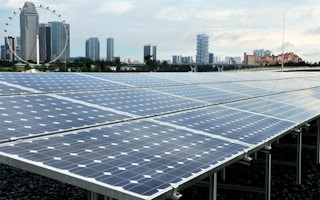With access to solar technologies becoming widely available across Asia, new solar financing solutions are also rapidly developing in the region, with Singapore poised to be the region’s hub for solar investment.
To continue reading, subscribe to Eco‑Business.
There's something for everyone. We offer a range of subscription plans.
- Access our stories and receive our Insights Weekly newsletter with the free EB Member plan.
- Unlock unlimited access to our content and archive with EB Circle.
- Publish your content with EB Premium.
Outlining these observations in a new report released last week, energy advisory firm DNV GL said innovative financing models are critical to broaden the sources of capital to meet the growth of the solar industry.
In a new report titled, “Bright Ideas: Global Trends in Solar Finance”, it highlighted the growing trend of a mix of traditional and innovative finance models currently being used worldwide, which include securitisation, debt and equity offerings, direct sales and even crowdfunding.
In Asia, the Singapore government has pledged to install 350 MW of solar power by 2020. With the growth of its domestic market and the expansion of various financing opportunities, the city-state could lead the region as a hub for solar investment, noted the multinational firm.
Mathias Steck, DNV GL-Energy’s regional manager for Asia Pacific, said that while solar technologies are innovating very quickly, new financing solutions are also rapidly catching up. “From green bond issues to crowdfunding and crowdleasing – it’s all here,” added Steck.
Elsewhere in Asia, although demand for solar technologies doubled in Japan, China and Thailand in 2013 compared to the previous year, adoption has not reached its peak due to the challenges in financing the sector. But these could all change as solar finance models continue to innovate, said the report’s authors.
The study draws from DNV GL’s experiences and expertise in the field, having provided numerous services in energy advisory, from technology review to engineering support and asset management in more than 25 GW of solar projects around the world. The firm said it has worked with over 2,500 successful solar project financing.
“
From green bond issues to crowdfunding and crowdleasing – it’s all here
Mathias Steck, DNV GL-Energy’s regional manager for Asia Pacific
The report identified four emerging trends in solar finance:
- Securitisation is a traditional financing method which converts assets that cannot be easily sold into tradable securities. Applying this finance model to the solar sector could help reduce the capital requirement for domestic-scale solar deployment, said DNV GL.
- New sources of debt and equity is another traditional fundraising option explored by some companies in the US and Europe, noted the report. By placing the ownership of a large number of solar projects into liquid and publicly tradable vehicles, it offers investment avenues for a wider range of investors and deepens the pool of capital available to developers, it suggested.
- Alternative ways to sell electricity to consumers such as direct sales of solar power and private purchase agreements are on the rise, challenging the traditional role of power utility companies. This presents new business opportunities for independent power producers and solar PV developers to offer a “convincing package” and gain access to an untapped niche market for PV projects, it explained.
- Crowdfunding - an innovative fundraising campaign using online platforms to generate financial support from people across the world rather than by traditional financier credit committees - cannot be undermined, the report said. It noted that the scalability and reliability of solar’s investment returns makes it very attractive to millions of small investors who appreciate providing finance to community projects which employ clean energy. The report cited an example of a solar firm in China which used crowdfunding to raise funds worth US$1.6 million for the construction of an off-grid PV plant.
The report, however, warned that while these financing schemes offer an exciting new approach to existing business practices, investors must not overlook the technical risks and valuable lessons undertaken in each model.
Steck echoed the report’s conclusion: “Whatever the financing model of course, investments are only as good as the assets which underpin them.”

















